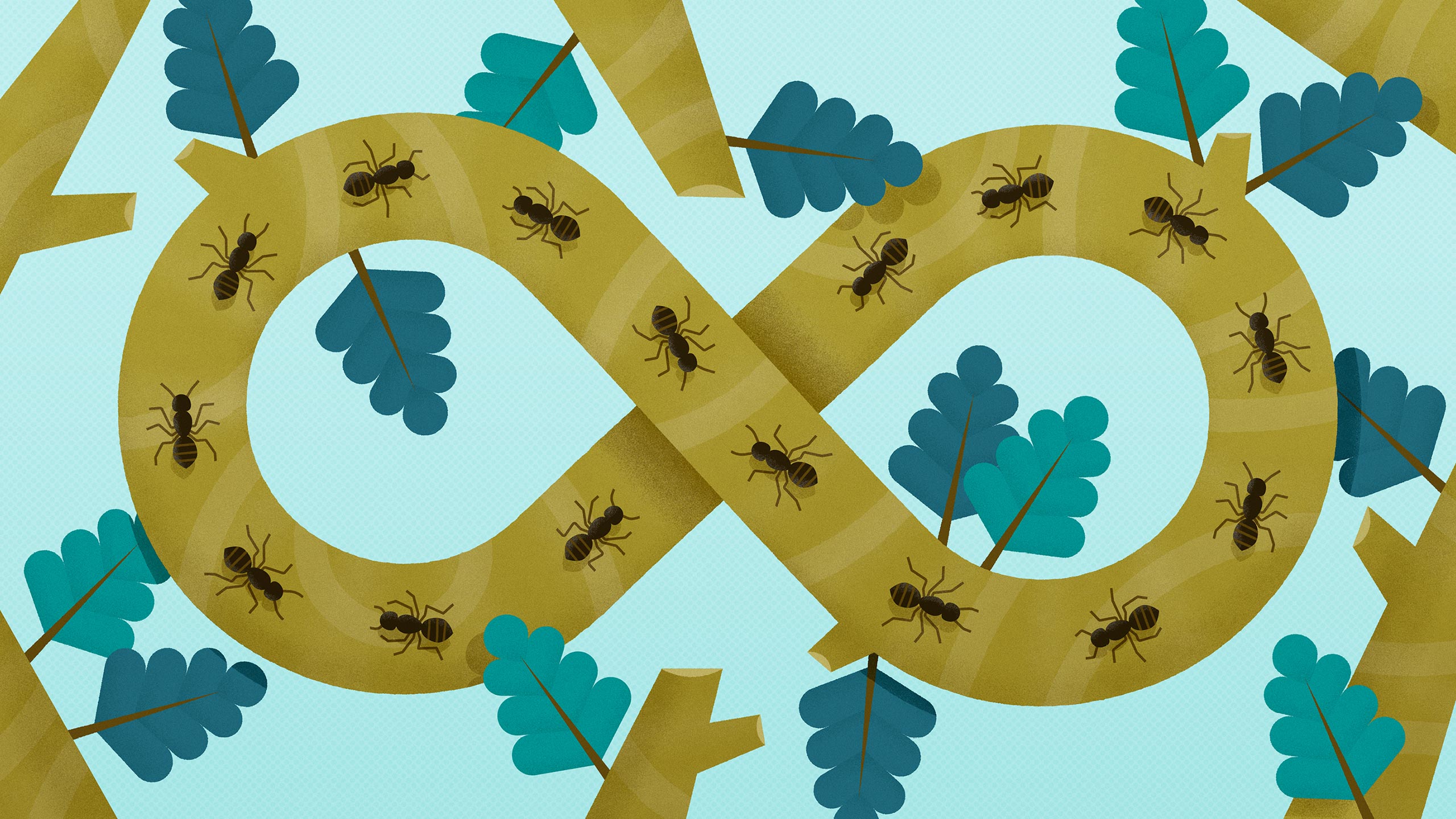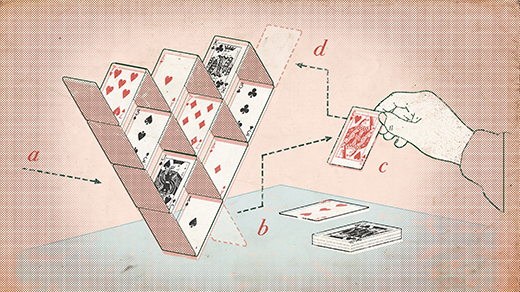Zen and the Art of Puzzle Solving

James Round for Quanta Magazine
Introduction
In five years of Insights puzzles, we’ve tried to present questions that lived up to the column’s name. Sometimes the intended insights have relied on simplified scenarios that shed light on scientific questions, such as Bell’s theorem or heredity, or on philosophical questions, such as elegance in mathematics or randomness. At other times, we’ve explored cutting-edge discoveries such as superconductivity in rotated sheets of graphene.
But insights can also be found in the very act of solving the puzzle itself, just as illumination may come from contemplating a Zen koan. This month, we present some classical puzzles that do exactly that.
Puzzle 1: The Zen of the Frenzied Ants
- Imagine a narrow twig spanning two mounds on an anthill to form a bridge 100 inches long. There are 10 ants on the twig, evenly spaced from the left end (let’s call this coordinate 0) to close to the right end (coordinate 90). You can ignore the lengths of the ants themselves. The five ants on the left are facing right, and the five on the right are facing left. All of the ants start walking in the direction they are facing at a constant speed of 100 inches/minute. The twig is so narrow that when two ants meet, they turn around instantaneously and walk away from each other at the same speed, exhibiting the kind of frenzied behavior typical of ants. When an ant reaches the end of the twig, it descends to the mound it has reached. How long does it take for the twig to be free of ants?
- In the same setting as above, imagine there are 100 ants on the twig. There are 75 facing left and 25 facing right, each at an unknown location on the twig, randomly interspersed with one another. The ant at the far left faces right, and the rightmost ant, which is close to the end of the twig but not quite there, faces left. The ants all behave as described above and move at the same speed. Obviously, there are many more collisions and reversals of direction. Now how long will it take for the twig to be cleared?
- In scenario b, which is the last ant to leave the twig, and which way was it facing originally?
Puzzle 2: Zen and the Art of Gambling
I invite you to a betting game played with cards. I’m the dealer. I charge you a fee for the privilege of playing, since the game is stacked in your favor and you have a positive expected winning amount with the best strategy. I then give you a pot of $100 to start the game, taken out of your entry fee. This pot may grow or shrink during the game depending on your ongoing wins or losses. You have to bet from this dynamic pot, and only from this pot — you cannot add anything else to it other than your winnings, which automatically go back into the pot.
I shuffle a regular deck of cards and put it facedown in front of you. You can make an even-money wager on whether the top card is black or red, betting any amount from zero up to the amount you currently have. Let’s say you bet $10 that the card is red. I then turn the card over. Depending on whether you are right or wrong, $10 is either added to your pot or taken away. Thus, if the card was black, you now have $90. If you then bet $20 dollars that the next card is black, and it is, you now have $110.
The game continues until all the cards are turned over, or your pot shrinks to zero. This means you have up to 52 chances to bet.
Obviously, once you know that the remaining cards are all of a certain color (you’re allowed to keep track of the flipped cards — I’m not a casino), you should bet the entire pot on the remaining color the rest of the way. But how do you bet before that point arrives? Here are some possible strategies.
- Steady: Bet $10 every round.
- Steady, with more risk: Bet $20 every round. You’re unlikely to lose five times in a row in the beginning, and you stand to make more when you win.
- Reckless: Bet your entire pot every round.
- Measured, with risk: Bet a quarter of your pot, but only on the color with more cards left; if equal numbers of cards of both colors are left, bet nothing.
- Cautious: Bet nothing at all until all cards left are the same color.
- Measured and cautious: Bet nothing if equal numbers of cards of both colors are left. Otherwise bet on the color that has more cards left — $10 for every extra card of that color up to the limit of your pot.
- Probabilistic: Calculate the ratio between the remaining cards of the two colors, with the larger number in the numerator so that the ratio is always 1 or more. Multiply it by 10 and bet that many dollars on the color with more cards left, or on either color if the remaining cards are equal.
Questions
- Which of the above strategies looks best in terms of expected winnings, and which looks worst?
- Modify any of these strategies or create an entirely new one that you think will maximize your expected winnings. If you can, calculate your expected winnings. If not, just specify your strategy, and we will calculate it for you in the solution.
- Estimate or calculate how much I should charge as an entry fee for this game, so that I, as the dealer, can at least expect to break even.
Puzzle 3: The Zen of Accepting the Empty Seat
You are invited to an event that has 100 assigned seats. You arrive last, but the person who arrived first, a VIP, did not have his assigned seat number and occupied some random seat that he liked. As the rest of the guests arrived, they took their assigned seats if they were unoccupied, or any arbitrary seat if not. Only one seat is left when you arrive. What is the chance that it is your assigned seat?
As I mentioned, these are all insight problems. You might have to wade into their complexity initially, but with calm, relaxed, Zen-like meditation, you may be able to solve them, or at least understand, why their solutions work, in a simple, intuitive way. So here are some quasi-Zen aphorisms that might help you. Apply them wisely.
- “Banish ye the clutter of complications with the sudden wisdom of insight.”
- “Follow ye the message, not the messenger.”
- “Hold ye to what is constant. Shun the transient and changeable.”
- “Remember, building the most complex temple starts with the first brick.”
Because these problems depend on insight, we will not publish any reader solutions during the first week. You may contribute comments during that time, but they will only appear early if you limit yourself to discussing your choice of strategy in Puzzle 2 or, if you’ve discovered the insight, to giving veiled hints or Zen aphorisms about it, or describing how you felt when you got it. Complete solutions described by readers will only be released a week from today.
May you be showered with insights.
Editor’s note: The reader who submits the most interesting, creative or insightful solution (as judged by the columnist) in the comments section will receive a Quanta Magazine T-shirt or one of the two Quanta books, Alice and Bob Meet the Wall of Fire or The Prime Number Conspiracy (winner’s choice). And if you’d like to suggest a favorite puzzle for a future Insights column, submit it as a comment below, clearly marked “NEW PUZZLE SUGGESTION.” (It will not appear online, so solutions to the puzzle above should be submitted separately.) Update: The solution has been published here.



